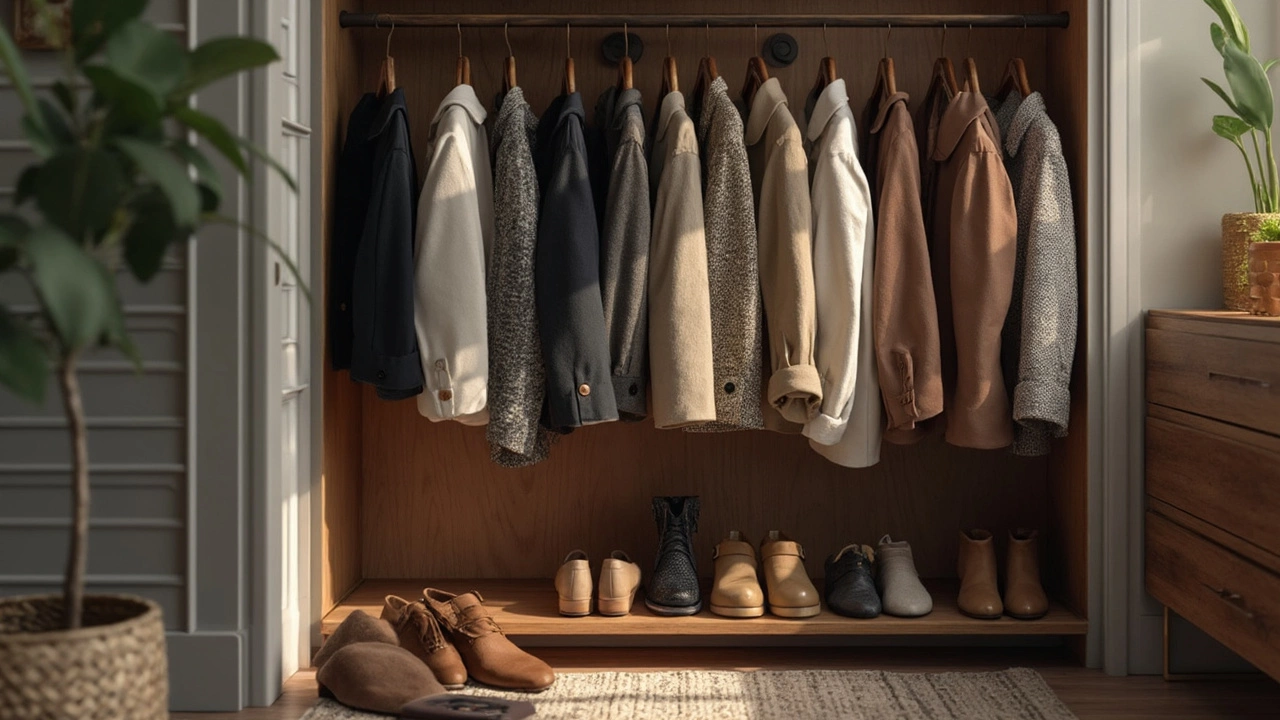Ever find yourself staring at your closet, wondering what on earth is appropriate to wear for your role as a teaching assistant? You're not alone. Nailing the right look can be a bit of a puzzle, especially when you're trying to strike a balance between looking professional and being approachable to your students.
First off, it's important to understand the dress codes that might be in place. Different schools and institutions have their own expectations. Some might lean more towards business casual, while others are quite laid-back. Always check if there's a specific policy to follow. No one wants to stand out for the wrong reasons!
Once you've got a grasp of what's expected, it's time to think about your fashion choices practically. Does this outfit allow you to move freely? Teaching often involves walking around, bending, or even standing for long periods. Comfort shouldn't be sacrificed for style. Keeping some versatile pieces that can mix and match easily is a smart move.
- Understanding Dress Codes
- Clothing Tips for New TAs
- Balancing Professionalism and Approachability
- Seasonal Wardrobe Changes
- Practical Considerations for Comfort
Understanding Dress Codes
So, what's the big deal about dress codes for teaching assistants? Well, they play a crucial role in shaping the way you interact with both students and colleagues. Your attire isn't just about looking good—it's about setting the right tone in the classroom. Let's get into the specifics.
School Policies and Expectations
Before anything else, you need to find out if your school has specific guidelines. Some universities and schools clearly define what's acceptable or not. A quick chat with HR or your direct supervisor can save you from any potential wardrobe faux pas.
Generally, dress code for TAs falls into a few categories:
- Formal or Business Attire: This is common in traditional settings where a suit and tie or equivalent is expected.
- Business Casual: Think khakis, polos, and blouses. It's professional but not too stiff.
- Casual: Some institutions are pretty relaxed. Here, jeans and a neat shirt might do the trick, but check if this flies at your place.
Impact of Dress on Classroom Dynamics
Your clothes can affect how you're perceived by students. Dressing too formally might create distance, making you seem unapproachable, while being too casual might undermine authority. Striking the right balance is key for a positive learning environment.
Consider this: a study from the Journal of Teaching in Higher Education suggests that students often connect better with educators who dress relateably yet professionally. This boosts engagement and trust.
Practical Examples
Here’s a handy table showing typical dress codes across different educational environments:
| Environment | Recommended Attire |
|---|---|
| Private University | Business Casual |
| Public High School | Casual to Business Casual |
| Community College | Casual |
Remember, whatever you choose, make sure it's clean, tidy, and suits the culture of your school. With these tips in mind, you’re ready to face your students looking the part!
Clothing Tips for New TAs
Starting out as a teaching assistant can be nerve-wracking, especially when it comes to figuring out what to wear. Fear not! With a few practical tips, you can find your footing quickly and dress to impress in the classroom.
Basics First: What To Always Have
Every TA should start with a few basic pieces. Think of them as your wardrobe core. Essentials include a good pair of black or neutral pants, a couple of dress shirts or blouses, and a sweater or blazer for layering. These staples are versatile and suitable for almost any setting.
Comfort Meets Professionalism
One key rule is finding the sweet spot between comfort and professionalism. You’ll be moving around a lot, so make sure your clothing allows for ease. Avoid overly tight garments. Remember, you're dressing for the job, but also for comfort.
Footwear That Works
Let’s talk shoes. You need them to be both comfy and smart-looking. While those high heels might seem appealing, they won’t feel great after a few hours. Choose supportive flats, loafers, or low heels to keep your feet happy through busy days.
Seasonal Adjustments
Your wardrobe might need some tweaks as the seasons change. In winter, layering with cardigans or lightweight jackets can keep you warm without compromising style. In warmer months, choose breathable fabrics. A scarf or a light sweater can add a touch of elegance to your look.
- Invest in moisture-wicking materials for maximum comfort during summer.
- Layer sensibly in cooler months without going overboard.
Dress Code Realities
Don't forget that dress code for TAs can vary a lot. While one institution might encourage creativity in attire, another might stick to a more formal code. Pay attention to what's common among your colleagues and let that guide you.
Here's a nifty table summarizing seasonal must-haves:
| Season | Must-Have |
|---|---|
| Winter | Cardigan, Thermal Layers |
| Spring | Breathable Blouses, Light Jacket |
| Summer | Moisture-Wicking Tops, Sunglasses |
| Fall | Scarf, Medium Coat |
By keeping these tips in mind, you’ll not only dress appropriately for your teaching role but also make a great impression. Each day you step into the classroom, your attire will reflect your readiness and professionalism.

Balancing Professionalism and Approachability
Figuring out how to dress as a teaching assistant often comes down to walking a fine line between looking professional and being friendly. You want your students to respect your authority, but you also want them to feel comfortable enough to approach you with questions or concerns.
Why Appearance Matters
Your outfit can set the tone for your interactions. Dressing a bit nicer than your students helps maintain a level of professionalism that encourages respect. However, going too formal might make you appear less approachable. Aim for the middle ground: think smart casual.
Practical Tips for Finding Balance
- Mute Colors and Simple Patterns: These are generally safe bets. Bright neon shades might be distracting, while simple patterns can keep your look interesting without being over the top.
- Comfortable Footwear: Whether you're in a classroom or a lab, you're likely to be on your feet a lot. Stylish flats or modest-heeled shoes often hit the mark.
- Layered Outfits: You never know when it's going to be chilly or warm inside a classroom. Layering helps you adjust to different temperatures with ease.
The Power of Relatability
Students tend to relate better to teachers who seem down-to-earth. Your attire can play a role in making you feel like part of the team. A casual jean jacket over a neat blouse, for example, can be a friendly yet neat choice.
To give you an idea, here's a quick look at an informal survey conducted amongst teaching assistants:
| Preferred Style | Percentage |
|---|---|
| Casual Yet Neat | 40% |
| Business Casual | 35% |
| Formal | 25% |
Bottom line? There’s no one-size-fits-all approach, but finding your sweet spot between professionalism and approachability will likely make your TA experience more rewarding for both you and your students.
Seasonal Wardrobe Changes
Keeping your wardrobe in sync with the seasons is more than just about staying stylish—it's about comfort and practicality too. For a teaching assistant, adapting to seasonal shifts is crucial, especially when you're spending long days in the classroom.
Spring and Summer
In warmer months, breathable fabrics like cotton are your best friends. They help you stay cool and comfortable through the day. Opt for light colors and loose-fitting clothes. A smart, casual look could include a nice pair of khakis or a modest skirt paired with a shirt or blouse. Don't forget to check if your institution has any restrictions on shorts or sleeveless tops, as policies can vary widely.
"As Albert Einstein said, 'The only source of knowledge is experience.' If you find yourself sweating through a lesson, it's a lesson learned—dress smarter next time!"
Autumn and Winter
When it gets chilly, think layers. Wearing layers allows you to adjust easily to the fluctuating indoor and outdoor temperatures. Consider investing in a few cardigans or blazers that you can throw over a shirt or sweater. Wool is a popular choice for these months as it retains heat well. Avoid bulky jackets if you are moving between rooms or buildings a lot; they can be cumbersome.
- Avoid loud colors or oversized clothing that can distract from classroom activities.
- Consider practical footwear. You're likely on your feet much of the day.
Quick Tips
Different seasons might require you to think about other accessories too. Sunglasses for outdoor teaching or waterproof coats for unexpected autumn rain can make all the difference in your day.
Keeping a small change of clothes or extra layers in your classroom or locker is a good idea. Those temperature-controlled classrooms can sometimes feel like the Arctic!
Finding the right seasonal balance in your teaching assistant attire doesn't have to be difficult. Remember that the key is comfort and professionalism—it will help you focus on teaching rather than what you're wearing.

Practical Considerations for Comfort
Being a teaching assistant means you’re always on the move. The right outfit can make or break your day, especially when comfort is at stake. Nobody wants to be tugging at a tight jacket or regretting their shoe choice halfway through a busy day.
Choosing the Right Footwear
Your feet carry you through the entire day, so supporting them is crucial. Opt for shoes that have cushioned soles because standing or walking around class can be taxing. Avoid high heels or overly tight shoes, as they can lead to a lot of discomfort by the end of the day.
Layering for Temperature Control
Classrooms can vary in temperature, so dressing in layers is a smart move. It means you can adapt to chilly mornings or surprise midday heat. Think light sweaters or cardigans that you can easily add or remove.
Fabrics Matter
The fabric of your clothing can impact your comfort level significantly. Materials like cotton or linen are breathable and keep you cool, whereas synthetic fabrics might not be as forgiving, especially during warmer months.
Accessorizing for Functionality
While jewelry and accessories can jazz up an outfit, keep functionality in mind. Too many accessories can be cumbersome. Instead, use functional additions like a watch or simple stud earrings that won't snag on anything. A practical, organized bag is also a must – it's your mobile office.
Quick Stats on Comfort
| Clothing Item | Comfort Rating |
|---|---|
| Sneakers | 9/10 |
| Cotton Shirts | 8/10 |
| Denim Jeans | 6/10 |
| Casual Work Pants | 7/10 |
Keeping comfort at the forefront ensures you’re focusing on what truly matters – engaging and supporting your students. After all, the right attire helps not just in looking the part but feeling ready to take on whatever the day throws your way!





Write a comment